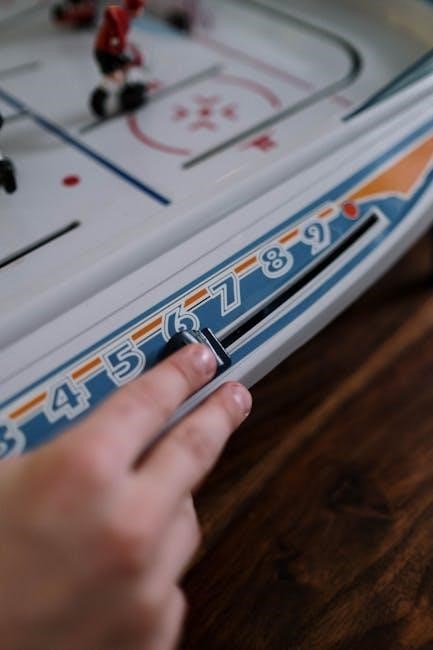Welcome to the SanDisk MP3 Player User Manual! This guide provides comprehensive instructions to help you navigate and maximize the features of your device effectively.
1.1 Purpose of the Manual
This manual is designed to guide users in understanding and utilizing their SanDisk MP3 player effectively. It provides detailed instructions for setup, operation, and troubleshooting, ensuring a seamless experience. The manual covers key features, compatible formats, and safety precautions to help users make the most of their device. Whether you’re transferring music, using advanced features, or maintaining your player, this guide offers clear, step-by-step directions. It is intended to be a comprehensive resource for both new and experienced users, helping them navigate all aspects of their SanDisk MP3 player with confidence and ease. By following this manual, users can optimize their device’s performance and enjoy their music effortlessly.
1.2 Scope of the Manual
This manual covers all essential aspects of the SanDisk MP3 player, ensuring users can fully utilize its features. It includes instructions for unboxing, charging, and initial setup, as well as detailing basic operations like powering on/off and navigating menus. Advanced features such as FM radio, voice recording, and customizable settings are also explained. The manual addresses music transfer methods, safety guidelines, and troubleshooting common issues. Additionally, it provides information on firmware updates, device maintenance, and best practices for optimal performance. By following this guide, users can explore every function of their SanDisk MP3 player and enjoy a hassle-free experience. The content is structured to cater to both new and experienced users, ensuring clarity and accessibility.
1.3 Target Audience
This manual is designed for all users of SanDisk MP3 players, catering to both first-time users and experienced individuals. It serves as a comprehensive guide for understanding the device’s features, troubleshooting common issues, and optimizing its performance. Whether you’re setting up your player for the first time or exploring advanced functionalities like FM radio or voice recording, this manual provides clear instructions tailored to your needs. It is particularly useful for those seeking detailed step-by-step guidance, ensuring a seamless and enjoyable experience with your SanDisk MP3 player.
Overview of the SanDisk MP3 Player
The SanDisk MP3 Player is a sleek, wearable device featuring an FM radio, voice recorder, and support for multiple music formats, designed for seamless music enjoyment.
2.1 Key Features of the SanDisk MP3 Player
The SanDisk MP3 Player offers a range of features designed for optimal music enjoyment. It includes a built-in FM radio, allowing users to tune into their favorite stations, and a voice recorder for capturing quick memos. The device supports various audio formats, ensuring compatibility with a wide range of music files. With a sleek, compact design and a user-friendly interface, the player is both portable and easy to navigate. It also features a durable battery life, providing hours of uninterrupted playback. Additionally, the device is compatible with both Windows and Mac operating systems, making it versatile for different users. These features make it an ideal choice for music lovers seeking a reliable and feature-rich MP3 player.
2.2 Device Components and Accessories
The SanDisk MP3 Player comes with essential components and accessories to enhance your experience. The device includes a high-quality earphone set for clear audio output and a USB cable for easy file transfers and charging. A removable clip is provided for convenient attachment to clothing, making it ideal for active use. The player also supports expandable memory via a microSD card slot, allowing users to increase their storage capacity. Additionally, a quick start guide is included to help users get familiar with the device’s functions. These components and accessories ensure that you can enjoy your music seamlessly and with maximum convenience wherever you go.
2.3 Compatible File Formats
The SanDisk MP3 Player supports a variety of audio file formats, ensuring compatibility with your music library. It plays MP3, AAC, WAV, FLAC, and WMA files, offering versatility for different audio preferences. Additionally, it supports audiobook formats like Audible, making it ideal for both music and spoken content. For video files, it supports MP4 and AVI formats, though this feature may vary by model. The device also supports FM radio broadcasts, enhancing its functionality beyond stored media. This broad compatibility ensures that you can enjoy a wide range of content seamlessly on your SanDisk MP3 Player.

Getting Started with Your SanDisk MP3 Player
Welcome to your SanDisk MP3 Player! This section guides you through unboxing, initial setup, and essential steps to prepare your device for use.
3.1 Unboxing and Initial Setup
Begin by carefully unboxing your SanDisk MP3 player, ensuring all components, such as the device, USB cable, and clip (if applicable), are included; Charge the player using the provided USB cable until the battery is fully powered. Once charged, turn on the device and follow the on-screen instructions to set your preferred language and other initial settings. For first-time users, familiarize yourself with the buttons and navigation system. If your model includes a wearable clip or wristband, attach it securely. Finally, transfer your music files or install necessary software to complete the setup process. Refer to the manual for detailed guidance.
3.2 Charging the Battery
To charge your SanDisk MP3 player, connect it to a computer or USB charger using the provided USB cable. Ensure the cable is securely plugged into both the device and the charging source. The player will automatically begin charging, indicated by an LED light or on-screen notification. Allow the battery to charge fully, which typically takes about 3 hours. Avoid overcharging, as this can reduce battery life. Once charged, disconnect the device and it will be ready for use. Always use approved SanDisk charging accessories to prevent damage. If the battery is completely depleted, it may take a few minutes before the charging indicator appears.
3.3 Connecting the Player to a Computer
To connect your SanDisk MP3 player to a computer, locate the USB port on both devices. Insert the smaller end of the USB cable into the player’s port and the larger end into the computer’s USB slot. Ensure the cable is securely connected. Your computer should automatically recognize the device as a removable drive. Open “My Computer” or “This PC” to locate the player under “Devices” or “Portable Devices.” For optimal functionality, download and install the latest SanDisk software from their official website. This software may include drivers and management tools to facilitate music transfer and device updates. Once connected, you can transfer music files via drag-and-drop or use the provided software for organized transfer. Always use the original USB cable to prevent connectivity issues.
Basic Operations of the SanDisk MP3 Player
Learn to power on/off, navigate the menu, and play music with ease. Use the Power button to start the device and explore intuitive controls for seamless operation.
4.1 Powering On/Off the Device
To power on your SanDisk MP3 player, press and hold the Power button until the screen lights up. This typically takes a few seconds. Once powered on, you can navigate through the menu and start playing music. To turn the device off, press and hold the same Power button until the screen turns off. The player may also automatically shut down if left inactive for an extended period. Ensure the device is fully charged before use, as a low battery may affect performance. The Power button is usually located in the center of the player, making it easily accessible for quick operations.
4.2 Navigating the Menu System
Navigating the SanDisk MP3 player’s menu system is straightforward. Press the Power button to wake the device, then use the navigation buttons (Up, Down, Left, Right) to scroll through options. The center Select button confirms your choice. To access the main menu, press the Power button briefly. From there, you can browse options like Music, Settings, FM Radio, and Playlists. Use the Up and Down buttons to scroll through lists, and the Left button to go back to the previous screen. The Right button often advances to the next screen or skips tracks during playback. The menu is intuitive, allowing quick access to features and settings for a seamless user experience.
4.4 Playing Music and Managing Playlists
To play music, select the Music option from the main menu using the navigation buttons. Choose a song or album to begin playback. Use the Up/Down buttons to adjust volume and the Left/Right buttons to skip tracks. To manage playlists, go to the Music menu and select Playlists. Here, you can create, edit, or delete playlists by selecting Add or Remove options. You can also shuffle or repeat tracks by accessing the Settings menu during playback. The device supports drag-and-drop and software-based playlist management, ensuring efficient music organization. This feature-rich system allows for a personalized and enjoyable listening experience tailored to your preferences.

Advanced Features of the SanDisk MP3 Player
The SanDisk MP3 Player offers advanced features like FM radio, voice recording, and customizable settings. These features enhance your listening experience and provide versatility in usage.
5.1 Using the Built-in FM Radio
The SanDisk MP3 Player features a built-in FM radio, allowing you to enjoy live broadcasts on the go. To use this feature, navigate to the radio menu, scan for available stations, and save your favorites. You can preset up to 40 stations for easy access. Use the tuning controls to adjust frequencies and ensure optimal reception. The digital tuner provides clear sound quality. For best results, use the included headphones, which also act as an antenna. You can switch between radio and music modes seamlessly, making it easy to listen to your favorite shows or discover new stations while on the move.
5.2 Recording Voice Memos
The SanDisk MP3 Player includes a voice recording feature, perfect for capturing quick notes, ideas, or important conversations. To begin recording, access the voice memo option in the menu, then press the record button. The built-in microphone ensures clear audio capture. You can save recordings directly to the device or a memory card. Recordings are stored in a dedicated folder for easy access. Use the playback function to review your memos or transfer them to a computer for storage or sharing. This feature is handy for lectures, interviews, or personal reminders, making the player a versatile tool for both entertainment and productivity.
5.3 Customizing Settings
Customizing your SanDisk MP3 Player allows you to tailor the device to your preferences. Navigate to the settings menu to adjust options like playback settings, FM radio presets, and equalizer modes. You can also customize the display, such as brightness and screen timeout, for optimal visibility. Organize your music library by creating playlists or sorting files by artist, album, or genre. Additionally, you can set a default startup mode, such as launching the music player or FM radio upon powering on. Explore the menu to discover more personalization options, ensuring your device functions exactly how you want it to enhance your listening experience.

Transferring Music to the SanDisk MP3 Player
Transfer music to your SanDisk MP3 Player via USB or drag-and-drop method. Ensure files are in compatible formats like MP3 or AAC for smooth playback.
6.1 Supported Music Formats
Your SanDisk MP3 Player supports a variety of audio formats, including MP3, AAC, WMA, and FLAC. Some models may also support WAV and OGG formats. To ensure compatibility, always check your device’s user manual for the full list of supported formats. Using unsupported formats may result in playback issues. For optimal performance, convert files to a compatible format before transferring them to your player. This ensures smooth playback and maintains audio quality.
6.2 Using Drag-and-Drop Method
To transfer music to your SanDisk MP3 Player using the drag-and-drop method, connect the device to your computer via USB. Once connected, your computer will recognize the player as a removable storage device. Locate your music files on your computer, then drag and drop them into the designated music folder on the player. This method supports various audio formats like MP3, AAC, and WMA. Ensure the files are compatible with your device for smooth playback. You can also organize files into folders for better management. This simple process allows quick and efficient music transfer without additional software.
6.3 Using Media Management Software
Using media management software is an efficient way to transfer music to your SanDisk MP3 Player. Install compatible software like Windows Media Player or SanDisk’s Media Converter. Connect your device to the computer via USB and open the software. Import your music files into the library, select the files you wish to transfer, and sync them to the player. The software automatically organizes files and converts them to compatible formats if needed. This method ensures seamless transfer and management of playlists, albums, and genres. It also helps maintain device compatibility and optimizes music playback quality. Follow the software’s instructions for a smooth experience;
Safety Tips and Precautions
Ensure safe usage by following guidelines: avoid high-volume listening, keep the device dry, and prevent extreme temperature exposure. Read the manual thoroughly for detailed precautions.
7.1 General Safety Guidelines
To ensure safe and optimal use of your SanDisk MP3 player, follow these guidelines: Avoid exposure to water or extreme temperatures. Keep the device dry and store it in a cool, dry place. Prevent prolonged listening at high volumes to avoid potential hearing damage. Always handle the player with care to avoid physical damage. Read the entire manual before use to understand proper operation. Ensure the device is at low volume or powered off when not in use. Adhere to all safety precautions to maintain functionality and longevity of your SanDisk MP3 player.
7.2 Hearing Safety
Protect your hearing by following these guidelines: Avoid listening at high volumes for extended periods, as it may cause permanent hearing damage. Always start with a low volume and adjust to a comfortable level. Take regular breaks from listening to give your ears time to rest. Use high-quality headphones or earbuds to ensure clear audio at lower volumes; If you experience discomfort or ringing in your ears, discontinue use immediately. Parents should monitor children’s volume levels to ensure safe listening practices. Refer to your device’s manual for volume-limiting features, if available, to promote hearing safety while enjoying your music.
7.3 Device Care and Maintenance
Proper care ensures your SanDisk MP3 player lasts longer and performs optimally. Avoid exposure to moisture, extreme temperatures, or physical stress. Clean the screen and exterior with a soft cloth and mild soap solution. Regularly update firmware for improved functionality. Store the device in a protective case when not in use. Handle the battery carefully; avoid overcharging or draining it completely. Transfer files via USB carefully to prevent data corruption. For internal memory management, periodically delete unused files. If issues arise, consult the manual or contact support. By following these steps, you can maintain your MP3 player and enjoy uninterrupted music playback.

Troubleshooting Common Issues
This section addresses common problems like device not turning on, music not playing, or connectivity issues. Consult the manual or contact support for swift resolution.
8.1 Device Not Turning On
If your SanDisk MP3 player fails to turn on, start by ensuring the battery is sufficiently charged. Connect it to a USB port using the provided cable and let it charge for at least 30 minutes. Verify that the charger is functioning properly and that the charging port is free from debris. If the issue persists, check for any visible damage to the battery or charging port. Press and hold the power button for 10-15 seconds to force a restart. If the device remains unresponsive, consult the manual or contact SanDisk support for further assistance. This step-by-step guide helps resolve power-related issues effectively.
8.2 Music Not Playing
If your SanDisk MP3 player isn’t playing music, ensure the volume is not muted or set too low; Check that the file format is compatible with the device, as SanDisk players typically support MP3 and WAV files. Verify that the files are not corrupted by transferring them to a computer and testing playback. If using external storage, ensure the memory card is properly inserted and formatted. Restart the device by holding the power button for 10-15 seconds. If the issue persists, reset the device to factory settings or update the firmware. For unresolved problems, consult the user manual or contact SanDisk support for assistance.
8.3 Connectivity Problems
If your SanDisk MP3 player is experiencing connectivity issues, first ensure the USB cable is securely connected to both the device and the computer. Try using a different USB port or cable to rule out hardware faults. Restart both the player and the computer to reset the connection. If the device is not recognized, ensure it is properly configured in the correct USB mode (e.g., MSC or MTP). Update or reinstall the USB drivers from the SanDisk official website. If the issue persists, format the device using the built-in settings, but be aware this will erase all data. For unresolved connectivity problems, perform a factory reset or contact SanDisk support for further assistance.
Firmware Updates and Maintenance
Regular firmware updates ensure optimal performance and add new features. Use the SanDisk official website to check for updates and follow on-screen instructions to install them.
9.1 Checking for Firmware Updates
To ensure your SanDisk MP3 player runs smoothly, regularly check for firmware updates. Connect your device to a computer and visit the official SanDisk website. Navigate to the support page, download the Sansa Updater Tool, and follow the on-screen instructions to check for available updates. Select your device model from the list, and the tool will automatically detect and download the latest firmware. Once downloaded, the updater will guide you through the installation process. Ensure the device remains connected until the update is complete. After installation, restart your player to apply the new firmware. Regularly checking for updates ensures you have the latest features and performance improvements.
9.2 Installing Firmware Updates
Installing firmware updates on your SanDisk MP3 player is essential for optimal performance. Connect your device to a computer using a USB cable and ensure it is in USB mode. Download and install the Sansa Updater Tool from the official SanDisk website. Launch the tool, select your device model, and follow the prompts to download the latest firmware. Once downloaded, the tool will automatically install the update on your player. Do not disconnect the device during the installation process. After completion, a confirmation message will appear. Safely eject the device from your computer and restart it to apply the updates. Always verify the firmware source to ensure it is official and secure.
9.3 Resetting the Device
To reset your SanDisk MP3 player, first ensure the device is powered off. Locate the small “Reset” button, typically found on the bottom or side of the player. Use a thin object, such as a paper clip, to press and hold the Reset button for 10 seconds. Release the button and reconnect the device to your computer. The player will initialize as if it were new. Note that resetting will erase all settings and data, so back up your files before proceeding. If issues persist after resetting, contact SanDisk support for further assistance. This process restores the device to its factory settings, resolving many software-related issues.
10.1 Summary of Key Features
The SanDisk MP3 Player offers a sleek, wearable design with features like FM radio, voice recording, and compatibility with multiple audio formats. Models such as the Sansa Clip, Clip Jam, and Clip Sport Plus provide long battery life, expandable storage options, and user-friendly interfaces. These devices support popular file formats like MP3, WMA, and FLAC, ensuring versatile music playback. With durable construction and intuitive controls, SanDisk MP3 Players are designed for seamless music enjoyment on the go. Their compact size, clip-on designs, and robust feature sets make them ideal for fitness enthusiasts and music lovers alike. This summary highlights the core benefits of SanDisk MP3 Players.
10.2 Best Practices for Usage
- Always read the user manual thoroughly before using the device to ensure proper operation.
- Keep volume levels moderate to protect hearing and avoid potential damage;
- Regularly update firmware to access new features and security improvements.
- Organize music files and playlists for easy navigation and playback.
- Avoid exposing the device to extreme temperatures or moisture to maintain performance.
- Use original accessories to ensure compatibility and optimal functionality.
- Charge the battery according to the manual’s guidelines to prolong its lifespan.
- Clean the device periodically to prevent dust buildup and maintain sound quality.
10.3 Resources for Further Assistance
For additional support, visit the official SanDisk support page, where you can find detailed FAQs, troubleshooting guides, and downloadable manuals. The SanDisk Downloads section offers the latest firmware updates and software tools. Contact SanDisk Customer Support directly for personalized assistance. Additionally, community forums and online tutorials provide valuable insights and tips from experienced users. Ensure to refer to official sources for accurate and reliable information.
